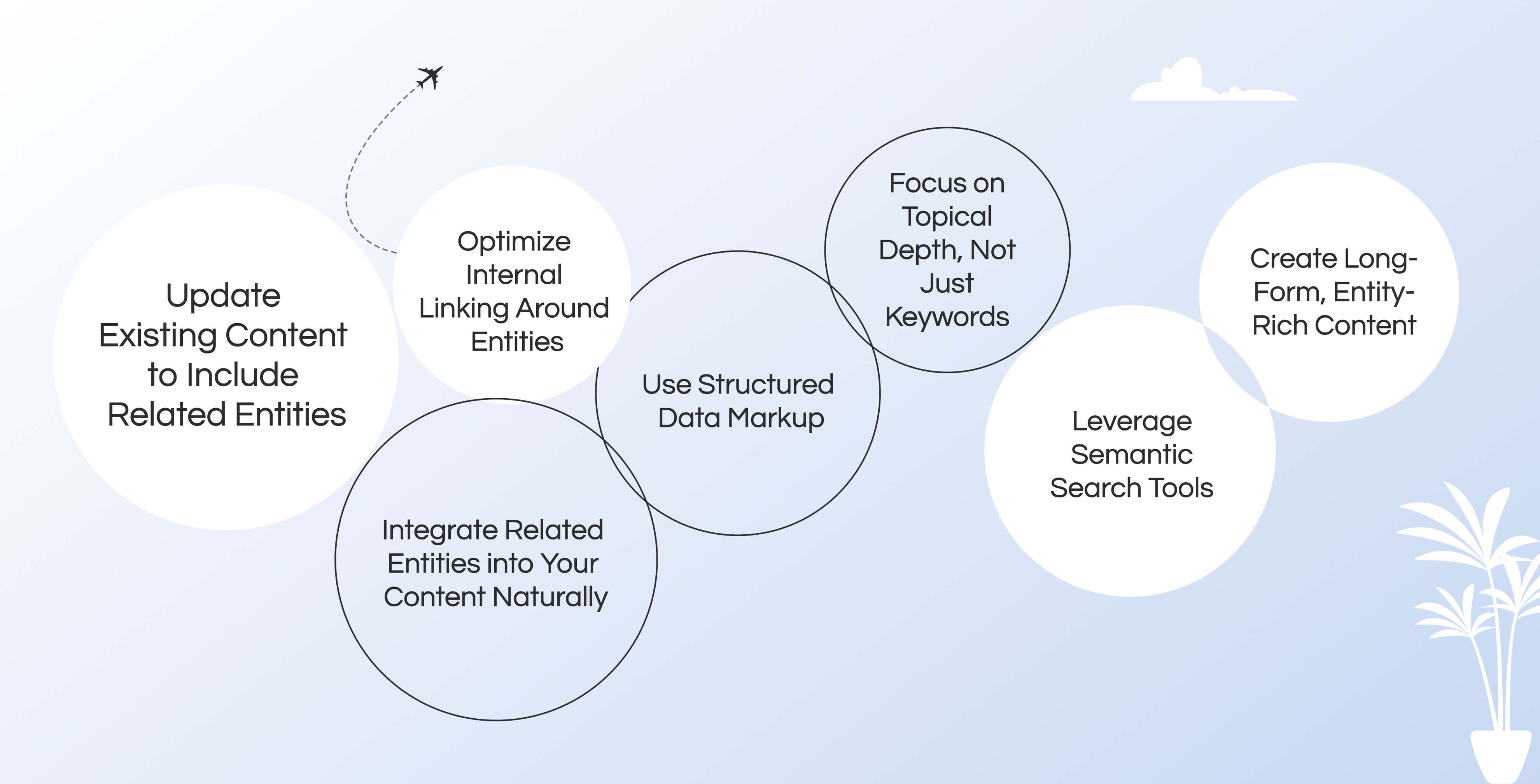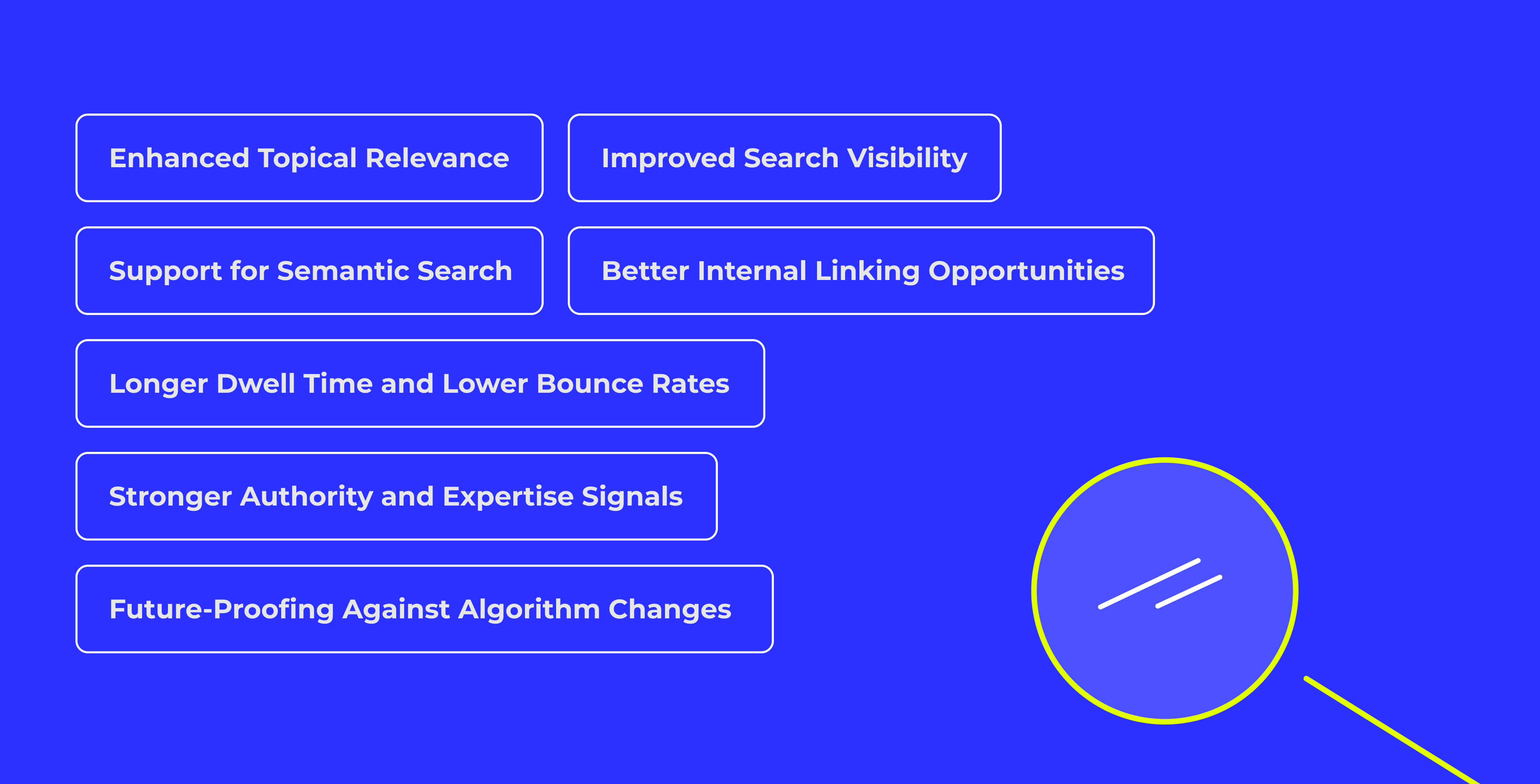How to Find Related Entities SEO and Strengthen Your Online Presence

 10 min
10 min
One approach is transcending the noise in the always changing terrain of search engine optimization (SEO) by knowing and using related things. Though keywords still have value, search engines have evolved in intelligence. They examine relationships and context rather than only at separated words. Here is where connected entities find application. These linked terms enable search engines to grasp the larger meaning behind a query, therefore increasing the contextually relevance of your material and hence its discoverability.
Consider it this way: related entities are the hints that enable search engines to view the whole picture, much as keywords are the individual jigsaw pieces. When Google seeks to grasp the term "digital marketing," for example, it does not stop there. It links it automatically to terms like "SEO," "content marketing," "PPC," and even "branding." These connections are not haphazard; they reflect Google's knowledge of the real-world links between ideas.
Learning how to find related entities SEO helps you to effectively leverage the deeper semantic understanding search engines give top priority. This exercise not only improves your visibility but also confirms your authority on the topic. This post will go over what related entities are, how to properly find them, and why they important for your SEO plan.
Understanding Related Entities in SEO
You have to know the "what" before digging into the "how." Related entities in SEO are ideas, brands, sites, or subjects closely associated with your main term in context. Unlike conventional keywords that concentrate on
specific terms, related entities enable search engines to grasp the larger background and links among several terms.
For instance, related entities might include words like "attorney," "legal services," "litigation," and "courtroom," should your core keyword be "law firm." These are not only synonyms; they also have contextual relevance and enable search engines to present a more whole picture of your material.
The Knowledge Graph of Google is a shining illustration of how search engines make use of related items. Originally introduced in 2012, the Knowledge Graph is basically Google's attempt to grasp the links among several bits of data. If you search for "Albert Einstein," you get a complete panel full of his birth date, scientific contributions, and comparable personalities like "Isaac Newton" or "Stephen Hawking" not just links to websites. This is the power of knowing how to identify connected entities. SEO lets you match your material to Google's interpretation of real-world relationships.
Boost Your Online Authority Today
Related entities can skyrocket your brand credibility. We’ll show you how—just tell us a bit about your business.
Strengthen My SEO Now
How to Find Related Entities in SEO

Locating connected entities is both art and science in some measure. It's not only about choosing synonyms or variants of your main keyword but also delving further into terms that really relate to the subject. Here's how to accomplish it:
Use Google search tools
Google's "People Also Ask" and "Related Searches" sections are gold mines for linked entities. If you search for "digital marketing," for example, you will come across under these features terms "social media marketing," "SEO strategies," and "content marketing." These are not only recommendations; they are entities Google connects with your primary search.
Explore SERP Panels and Google Knowledge Graph
Google sometimes shows Knowledge Graph panels when you search for notable people, companies, or subjects. Examine the related terms Google lists next to the primary entity. These are high-confidence relationships that provide you understanding of what Google thinks to be connected.
Apply tools such Google's NLP API, Ahrefs, and SEMrush.
By examining semantic relationships in top-ranking material, advanced SEO technologies have made it simpler to find related things. Particularly strong is Google's Natural Language Processing (NLP) API since it groups text into entities and displays their relevance.
Examine Competitive Material
Search high-ranking pages for your desired keywords and examine their word choice. You will frequently see recurrent themes and words connected to the major issue in context. These are possible linked entities you might include into your own content plan.
Go into Whitepapers and Industry Publications
Many times, major industry journals employ exact language that search engines find to be linked entities. If you are writing on "cloud computing," for instance, whitepapers often include terms like "SaaS," "virtualization," and "data centers," so demonstrating a strong contextual link.
Knowing where to locate similar entities SEO is about matching your content with how search engines view context, not only about raising search prominence. Mastery of this will help you to improve relevance, rankings, and user interaction.
Let’s Map Out Your Entity SEO Strategy
Want to dominate semantic search? Our team is ready to build a custom strategy around your niche.
Schedule a Free Consultation
Strategies for Implementing Related Entities

The actual question is—how can you employ related entities effectively? You now know what they are and how to identify related entities SEO. Identifying linked entities is one thing; it's quite another to weave them naturally into your SEO plan for best effect. Here are practical ideas meant to change your approach:
Integrate Related Entities into Your Content Naturally
It won't cut it just sprinkling keywords. When you find linked entities, try to include them into your material in a natural and organic sense. Ste clear of the trap of keyword cramming. If your main keyword is "cloud computing," for example, and your linked entities include "SaaS," "virtualization," and "data storage," your material should logically flow using these terms in meaningful sentences.
Use Structured Data Markup (Schema Markup)
Structured data is among the least used tactics in SEO. Schema Markup lets search engines know how entities in your content relate one another. If you are discussing "law firms," for instance, you might define "attorneys," "litigation," "court cases," and more using schema. This clarifies for search engines not only the entities themselves but also their relationships.
Focus on Topical Depth, Not Just Keywords
SEO is developing. Google today prefers material showing topical depth above surface keyword repetition. If you're writing on "digital marketing," explore closely linked ideas such "SEO," "PPC," "content marketing," and "social media strategies." This method increases your relevancy by sending search engines strong contextual signals.
Optimize Internal Linking Around Entities
Another approach to clearly present linked entities is internal linking. Link a connected entity you mention to another piece of material delving deeper into that issue. This enhances user experience as well as makes search engines better able to grasp the semantic links across your website.
Leverage Semantic Search Tools
Discover similar entities you might not have thought about using tools including Google's NLP API, Ahrefs, and SEMrush. These tools will help you find terms often co-occurring with your main keywords in high-ranking content.
Create Long-Form, Entity-Rich Content
Longer content usually ranks better since it naturally gives related entities more room. Covering "user experience," "conversion rate optimization," "shopping cart abandonment," and more, a 1500-word article on "e-commerce SEO" can This lets Google view your material as complete and authoritative.
Update Existing Content to Include Related Entities
Start fresh, but also maximize your current material by going back over it and adding related entities where it makes sense. Along with increasing your relevance, this refresh tells Google your material is current.
You are really playing the same game as Google when you become proficient in the skill of locating connected entities SEO and using them wisely. Your web of relationships is improving understanding, relevance, and finally your rankings.
Start Ranking Smarter
Related entity optimization isn’t a trend—it’s the future. We’ll help you lead, not follow.
Talk to Our SEO Team
Benefits of Using Related Entities for SEO

You might be wondering, "Is all this effort really worth it?" The short answer: Absolutely. Leveraging related entities isn’t just a neat SEO trick—it’s a transformative strategy. Here’s why:
Enhanced Topical Relevance
Google loves content that deeply understands a subject, not just skims the surface. When you include related entities, you’re telling Google that your content isn’t just keyword-focused—it’s contextually rich. This enhances your topical relevance and signals to search engines that your page is an authority on the subject.
Improved Search Visibility
Let’s be real: ranking on Google’s first page is a crowded space. Including related entities helps search engines understand the broader scope of your content, giving you more opportunities to appear for various related searches. For instance, a page optimized for "content marketing" that also includes entities like "blogging," "SEO," and "lead generation" is more likely to appear for those terms as well.
Support for Semantic Search
With Google’s algorithm updates like Hummingbird and BERT, the focus has shifted to understanding search intent rather than just matching keywords. Related entities support this shift by providing richer context, allowing your content to better match user intent.
Better Internal Linking Opportunities
When you identify and implement related entities, you naturally create more internal linking possibilities. Linking from one entity to a relevant article deepens user engagement and helps search engines understand your site’s structure better.
Longer Dwell Time and Lower Bounce Rates
Entity-rich content isn’t just for Google—it’s for your readers. When your content is thorough and contextually rich, readers are more likely to stay longer, engage deeper, and click through to related pages.
Stronger Authority and Expertise Signals
Google’s E-E-A-T (Experience, Expertise, Authoritativeness, Trustworthiness) guidelines emphasize the importance of authoritative content. When your content is packed with well-placed related entities, it conveys a strong signal of expertise and relevance.
Future-Proofing Against Algorithm Changes
SEO strategies come and go, but semantic relevance is here to stay. By mastering how to find related entities SEO and implementing them, you’re essentially aligning your strategy with Google’s long-term trajectory.
The bottom line? Related entities are not just the icing on the SEO cake—they’re the flour, sugar, and eggs that hold everything together.
Not Sure Where to Start? Let Us Help
Whether you're new to SEO or scaling fast, we’ll guide you through entity-focused optimization.
Contact Us Today
Common Mistakes to Avoid
It’s easy to get excited about integrating related entities, but it’s just as easy to make mistakes that can derail your SEO efforts. Here are the most common pitfalls and how to avoid them:
Overstuffing Entities
It’s tempting to cram as many related entities as possible into your content. But like traditional keyword stuffing, overloading your page with entities can look spammy and harm readability. Aim for natural inclusion. If it doesn’t fit organically, it’s better left out.
Ignoring Contextual Relevance
Not all related entities are created equal. Just because a term is loosely related to your main keyword doesn’t mean it belongs in your content. Always prioritize contextual relevance. If you’re writing about "social media marketing," forcing terms like "email automation" may dilute your focus.
Lack of Structured Data Implementation
Many site owners fail to use structured data to highlight their related entities. This is a missed opportunity for better indexing and enhanced search visibility. Make schema markup a regular part of your SEO strategy.
Neglecting User Experience
Overloading content with related entities at the expense of readability will hurt you in the long run. Remember, Google’s algorithms are getting better at understanding user experience. If your content is cluttered and hard to read, it won’t rank well—no matter how many related entities you include.
Failing to Refresh Old Content
SEO is not a one-and-done deal. If you’re not revisiting old content to update it with relevant entities and new insights, you’re leaving rankings on the table. Make it a practice to routinely audit and refresh your existing articles.
Not Mapping Out Entity Relationships
Simply listing related entities isn’t enough. You need to map out how they connect. If you mention "cloud computing," you should explain its links to "data centers," "virtualization," and "SaaS." This not only enhances user understanding but also helps Google grasp your content’s structure.
Overlooking Analytics and Performance Tracking
Finally, don’t forget to track how your entity-driven content performs. Use Google Analytics and Search Console to monitor which entities are driving traffic and which are falling flat. Adapt your strategy accordingly.
Mastering how to find related entities SEO is only half the battle. Implementing them correctly and avoiding common mistakes is what sets high-ranking content apart from the clutter.
Conclusion
Knowing how to find related entities SEO is an absolutely vital component of good digital marketing, not only a sophisticated optimization tool. In a time when semantic relevance and contextual understanding rule search engines, your material will stand out from the competitors if you can map out and apply connected entities.
See it as developing a relevant network. Every linked entity you mention serves as a thread linking your material to more general ideas search engines identify and rank. This increases your topical authority in addition to your visibility, thereby enhancing the value of your website to search engines as well as users.
Furthermore, when done right—by means of structured data markup, thematic depth, and deliberate internal linking—you are not only maximizing for keywords. You are building a rich web of knowledge that more completely satisfies user intent. Search engines like Google find just this kind of reward.
Mastery of this method is non-negotiable for companies and marketers trying to keep ahead. Working with an organic SEO agency that recognizes the value of linked entities will help you to reach even more and guarantee long-term success in an always competitive digital environment.
Before publishing it, would you like me to go over the whole blog looking for flow, consistency, and keyword integration?
FAQs
Related entities in SEO refer to concepts, terms, or topics closely linked to your main keyword. These entities help search engines understand the broader context of your content and establish its relevance. By using related entities, you improve the semantic meaning of your content for better ranking.
Using related entities can boost your SEO rankings by improving topical relevance and helping search engines better understand the intent behind your content. This leads to more accurate indexing and increased chances of ranking for a variety of related search terms.
You can find related entities by using Google’s “People Also Ask” and “Related Searches” sections, leveraging SEO tools like SEMrush or Ahrefs, or analyzing the top-ranking pages for your keywords. These resources help identify terms and concepts that search engines associate with your target keywords.
Yes, related entities can be used in any type of content, from blog posts to landing pages, and even in multimedia formats. Their inclusion enhances the depth of your content and supports a more comprehensive SEO strategy, helping search engines understand and rank your content better.
No, overuse of related entities can harm your content’s readability and lead to keyword stuffing. Instead, focus on integrating them naturally, ensuring they enhance the content’s value without overwhelming the reader. Balance is key to maintaining both relevance and user engagement.
By enriching your content with related entities, you provide more comprehensive and informative material, which enhances the user experience. When users find content that answers their questions thoroughly, they are more likely to stay on the page longer, improving engagement and reducing bounce rates.




